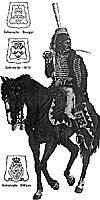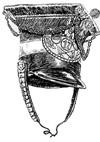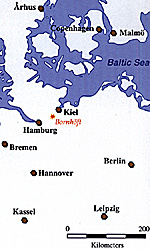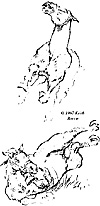In the afternoon of 7 December, 1813, nearly nine hundred cavalrymen from the Swedish corps of the Army of the North lined up on the frozen fields south of Bornhoft in northern Germany. Opposing them were about 5,000 men from the retreating Danish army, an ally of Napoleonic France. Less than two months before, Napoleon's Grande Armee had been defeated at the climactic battle of Leipzig 275 kilometers (165 miles) to the south. Now remnants of that once mighty army were streaming back to France and to fortresses such as Hamburg. Allied forces, including the Swedes, were in pursuit.
Very few Swedish units had fought in the 1813 campaign and the Swedish troopers at Bornhoft were as yet untried in battle but eager to show their mettle. In this, the third and final part of our study of the Swedish army during the 1813 campaign, they would get their baptism of fire.
After Leipzig
Large Swedish Mornerska Hussar and Uniform Color Chart
The Army of the North was one of three different Allied armies that had campaigned against the French and their allies in 1813. After some hesitation, Tsar Alexander, nominally commander-in-chief, reluctantly gave the Crown Prince permission to advance into Holstein. French Marshal Davout was attempting to hold this area north of Hamburg with the French 13th Corps and a Danish corps under Prince Fredrik of Hessen-Kassel.
During the last days of November Bernadotte's main force crossed the Elbe River to the northern bank. In addition to the Swedish corps it included a small Russian corps under Voronsov. It soon established contact with Wallmoden's corps of Russo-German legions which had been operating in Mecklenburg during the autumn.
Davout, who saw the defence of Hamburg as his main task, realized that he could not control the whole line between Lubeck and Hamburg with his limited resources. He therefore withdrew his French forces towards Hamburg leaving Prince Fredrik and the Danes to defend Holstein alone.
At right, headgear of the 17th.
Apparently the pursuing forces were not eager to fight. Lallemand was given "honors of war" with a promise that any pursuit would not start until 6:00 the next morning. At 10:00 p.m. on 5 December, Lallemand's brigade left Lubeck to join the rest of the Danish corps, which was pushed back towards Kiel by Wallmoden's advance guard.
The next morning a cavalry detachment led by General Skjoldebrand started the pursuit of the retreating Danes who were spread out on the road Lubeck-Segeberg-Kiel. In some accounts Skjoldebrand is described as an old and somewhat lethargic officer lacking in military skill, and the pursuit was carried out at a "moderate" pace.
After a day with no sign of the enemy, the town of Segeberg was reached in the evening which the Danes occupied. At the same time some elements from Wallmoden's corps came up from the south and the first exchange of fire was made with Lallemand's brigade camped inside the city walls. The skirmishing soon ended due to darkness and the Swedish soldiers were ordered to find quarters for the night.
At this point it is worth mentioning what happened to Ryttmastare Gyllenkrook and his squadron of the Mornerska Hussars who experienced an episode more familiar to a romantic novel. Late at night the squadron arrived at Pronstorf -- the country house of a certain Chamberlain Buchwaldt. This very evening the family was celebrating the 15th birthday of Buchwaldt's daughter with a great dinner and ball. As soon as the first of the Swedish cavalrymen were seen, the guests were terrified -- fearing that they were raiding Russian cossacks. The lights were put out and all doors and shutters were immediately closed.
When the Swedish hussars arrived, the place seemed totally abandoned. The only one who stayed calm inside the house was the chamberlain's wife, Louise Buchwaldt, who went out in the dark courtyard with a chandelier and asked the foreign soldiers what they wanted. "Just a glass of water", Gyllenkrook humbly answered. He was then invited to the ball which started again. One can imagine that the arrival of the Swedish hussars was an exciting "extra" to the party which made it a memorable experience for all the participants.
The weather was clear and the ground had frozen. The Danes were not far away and the Swedish troopers followed them northwards at a more energetic pace. Skjoldebrand may have felt pressure both from the Crown Prince and his men that today there had to be some action.
After some delay at a bridge which had been destroyed by the Danes, the advance elements of the Swedish force made contact with the Lithuanian uhlans forming the Danish rear guard south of Bornhoft. While a small skirmish went on along the road, Skjoldebrand and the main force followed just behind and soon reached the highest point on the open fields. The Swedish staff could see how the landscape changed at Bornhoft from open fields with shallow hills to more closed terrain broken up by hedges, stone walls and marshes.
Apparently Lallemand's infantry were trying to protect themselves from the pursuing cavalry by reaching this area. Another Danish force was also near the village of Bornhoft, and as soon as Lallemand joined them the odds would indeed be in the Danes' favor. The Swedes hurried to catch Lallemand's brigade, but just before the two forces were within range, the Danish infantry slipped behind an overgrown earth bank one kilometer south of Bornhoft which marked the start of very rugged terrain. Lallemand placed part of his brigade along this good defensive position to act as rear guard for the rest of his retreating force.
Where the road crossed the earth bank two cannon from battery Gerstenberg were unlimbered. East of the road one company each of the Slesvig Jagers and Holstein Sharpshooters deployed, and on the west side of the road stood one company Oldenburg Jagers. The rest of the Danish force was either retreating along the road, or deploying inside the village of Bornhoft.
The leading Swedish cavalry squadron pushed forward, but was met by a volley from the earth bank and two hussars dropped from their saddles. The advance guard was recalled and the Swedish cavalry force was put into attack formation. Skjoldebrand hesitated. The Danish force in front of him was much superior in numbers and the terrain was unsuitable for cavalry combat. However, could he afford to let the Danes simply withdraw without a fight? On his right and left were seven squadrons from what was known to be the finest cavalry regiment in the Swedish army -- the Mornerska Hussars.
The Mornerska Hussars were formed during the Seven Years War in response to the Prussian light cavalry forces which constantly harassed the Swedish army in northern Germany. The "Royal Swedish Hussar Regiment", as it was called then, was the first hussar regiment in the Swedish army and served as a model for the other light cavalry regiments which were to follow.
An interesting fact not widely known is that the later legendary Prussian general and field marshal Blucher started his career as a young hussar in this Swedish regiment during the Seven Years War. However, after a short service he was taken prisoner in 1760 by a Prussian patrol and served the rest of his life in the Prussian army.
Prussian drill and organization methods were used from the start for the Swedish hussars. Having its origins in northern Germany, the Mornerska Regiment used German command-terms during the Napoleonic Wars, even though the regiment was garrisoned in the south of Sweden by this time.
The regiment was used extensively for scouting and smaller raids in 1806-1807 and 1813, but it had not taken part in any larger action until Bornhoft.
"If it is going to happen, it is going to happen now!" Colonel Cederstrom of the Mornerska Hussars said to general Skjoldebrand. These words put an end to the hesitation of the Swedish commander and he gave the signal for attack. The buglers sounded the charge and the whole line started to advance. When they had trotted for a short distance, the two Danish cannon fired, but it went over the heads of the Swedish and Prussian cavalrymen. Along the earth bank the Danish infantrymen started to fire, but it was too early and the fire had no effect.
"They are scared", Skjoldebrand said to Cederstrom, "but now we must hurry so as to get at most one round of grape-shot [canister] against us", and he ordered the charge. The order was repeated along the line and the advance sped up to a full gallop. Skjoldebrand said later that at this point he looked to his right and his left and the line was still perfectly straight, "just as at the parade-ground".
The canister came just before they reached the guns. Colonel Cederstrom was wounded in his right arm, and fell from his horse. Skjoldebrand was afraid that this would bring disorder in the line and to cheer up the men he shouted "Hurrah!" which was repeated along the line and the pace was increased even more. The Danish gunners fled and the two guns at the entrance of the defile became the first booty for the Swedes.
At right, horse sketches © Keith Rocco
The horses easily jumped over the earth bank and the Jagers were ridden down. Although partly scattered, the Swedish squadrons then turned at the Holstein Sharpshooter battalion which was in the process of forming square. The Holstein infantry fired a half-hearted volley before the whole square broke and the men ran away to take cover in the numerous ditches and hedges. Led by party crasher Gyllenkrook and his squadron, the Swedish hussars continued into the defile where they joined the confused mass of fighting men moving towards the village.
Behind the Mornerska Hussars came the Skanska Hussars along with the Prussian hussars who passed the hedge without any resistance and continued towards the village without taking part in the crowded fight in the defile.
On the right side of the road the Swedes had a tougher time. Here one single squadron from the Mornerska Hussars faced one company of Schleswig Jagers reinforced with one company of Holstein Sharpshooters. The commander of the Swedish squadron was killed when he came near the earth bank, and the Swedish attack was checked.
The Swedes soon received reinforcements in the form of one squadron of the Skanska Carabiniers, which came up from behind. However, the attack was temporarily stopped once again when the carabiniers' standard bearer was killed. But after the carabinier's squadron commander picked up their standard and ordered the men forward, the carabiniers charged over the earth bank together with the hussars. This was more than the Danes could take and the infantry on the east side of the road broke and fled in all directions. The Swedish cavalrymen from the right wing then followed their comrades converging on the village.
In the village the intermingled mass of cavalrymen ran into the 1st battalion of the 3rd Jutland Infantry Regiment which compounded the confusion. It seemed as if the fighting went on in every corner of the village. The veteran Prussian Schill Hussars now joined the fight and some of the Swedish hussars were surprised by their fierceness. One Swedish officer later recalled how a Prussian hussar cut the head off a Danish trooper with a single slash.
However, north of Bornhoft at least nine Danish infantry battalions and several artillery batteries were deployed. When the lead elements of the Mornerska Hussars reached the northern entrance of the village, the Danes and Lithuanians managed to slip away, and the Swedes came under heavy fire.
Skjoldebrand decided that it was now time to stop. According to Ljunggren he ordered the Mornerska Hussars around him to follow but no one paid any attention. He then reminded himself that they still used command terms in German and gave the order "rechts um kehrt euch" and the hussars immediately lined up for the withdrawal.
When the Swedes reached the defile on their way back, they were met by fire from the Holstein Sharpshooters who had managed to regroup along the road. The Swedish hussars leaned down behind their horses necks and charged through the defile at the gallop, and the Danish fire only caused limited casualties.
The battle basically consisted of one Swedish cavalry charge overrunning a small Danish rear guard, a brief pursuit and melee in the village, and a withdrawal to the fields south of Bornhoft where the Swedes reformed after encountering the bulk of the Danish force. The Danes were not molested again by the Swedes as they continued their retreat towards Kiel.
The Swedes were really exhilarated after the action. Approximately 900 Swedish cavalrymen had attacked 5,000 Danes, and the message of a splendid Swedish victory spread through the army. However, if it was a victory it truly was a marginal one (the Danish writer Liebe even called it a Danish victory!). The Danes admitted losing 11 killed, 45 wounded, and 75 missing and prisoners versus the Swedes reporting 23 killed and 57 wounded. Half of the Swedish casualties were suffered by the Mornerska Hussars: 10 dead and 30 wounded, plus one missing. As an indication of the larger targets they make (as well as involuntary "shields" used by their riders) 74 horses were killed, wounded or missing by the Mornerska Hussars compared to the 41 cavalrymen the regiment lost in the battle.
And even if the Swedes could claim three captured guns and another 112 prisoners taken in the days following the battle, the Danish army was not broken. On 10 December Prince Fredrik was able to fight his way through Wallmoden's battalions at Sehested and reached the safety of the fortress of Rendsburg.
Although Napoleon would continue to fight on until forced to abdicate on 6 April, 1814, hostilities in this region soon ended and an armistice was signed on 15 December. Peace negotiations eventually led to the treaty of Kiel where Norway was ceded by Denmark to be united with Sweden. Bernadotte's strategic goal of the 1813 campaign had been accomplished.
On 28 January, 1816 the Mornerska Hussars were awarded two honorary standards with the name Bornhoft embroidered above the star of the Order of the Sword, for the courage they had shown during the 1813 autumn campaign in Germany and Holstein.
About the Author: Gustav P. Bergman lives in Sweden and works for the Swedish phone company Telia. He has a M.S. in Engineering Physics from Lund University. A history researcher for ten years and avid Napoleonic student, he has been published in various newspapers and magazines.
Mornerska Hussars
Related:
 After Napoleon was defeated at Leipzig, the Crown Prince of Sweden (former French Marshal Bernadotte) divided his Army of the North into three parts. Bulow marched to the Rhine with his Prussian 3rd Corps and Winzingerode's Russian corps marched on Bremen and continued into Holland. With the rest of the army -- which included all the Swedish units -- the Crown Prince planned an attack against the Danish army in Holstein in order to strengthen his claims on Norway as a Swedish acquisition.
After Napoleon was defeated at Leipzig, the Crown Prince of Sweden (former French Marshal Bernadotte) divided his Army of the North into three parts. Bulow marched to the Rhine with his Prussian 3rd Corps and Winzingerode's Russian corps marched on Bremen and continued into Holland. With the rest of the army -- which included all the Swedish units -- the Crown Prince planned an attack against the Danish army in Holstein in order to strengthen his claims on Norway as a Swedish acquisition.
A Slow Pursuit
 The Swedish army reached Lubeck on 5 December. This town was held by French General Lallemand with a small rear-guard consisting of two battalions of the Holstein Sharpshooters, one batallion from the Jutland Infantry Regiment, three squadrons of the Holstein Cavalry Regiment, and two squadrons of the 17th Lithuanian Uhlan (Lancer) Regiment.
The Swedish army reached Lubeck on 5 December. This town was held by French General Lallemand with a small rear-guard consisting of two battalions of the Holstein Sharpshooters, one batallion from the Jutland Infantry Regiment, three squadrons of the Holstein Cavalry Regiment, and two squadrons of the 17th Lithuanian Uhlan (Lancer) Regiment.
A More Aggressive Pursuit
 However, Gyllenkrook's squadron's fun was cut short, for some hours before dawn of 7 December Skjoldebrand was informed that Lallemand had left Segeberg. He also received a new order from the Crown Prince that implied dissatisfaction with the conduct of the pursuit. Some shuffling of units occurred as units were detached from Skjoldebrand's force while he received two squadrons of Schill's Prussian Hussars.
However, Gyllenkrook's squadron's fun was cut short, for some hours before dawn of 7 December Skjoldebrand was informed that Lallemand had left Segeberg. He also received a new order from the Crown Prince that implied dissatisfaction with the conduct of the pursuit. Some shuffling of units occurred as units were detached from Skjoldebrand's force while he received two squadrons of Schill's Prussian Hussars.
Senior Light Cavalry Regiment of Sweden
Baptism of fire
Panic in the Center
The center of the Swedish line rode into the defile where the Lithuanians were attempting to retreat, but the lancers were hindered by the Holstein cavalrymen and the guns in front of them. In a desperate attempt to get away the uhlans lowered their lances and charged into the Danish column along the road. For understandable reasons panic broke out among the Danish cavalry and artillery men in the column. But due to the lack of space the Swedish hussars had difficulties using their weapons and the road became an entangled mass of Swedes, Danes and Lithuanians.
The Left Breaks a Danish Square
 The left wing of the Swedish first line, consisting of three squadrons from the Mornerska Hussars, charged towards the earth bank where a company Oldenburg Jagers fired at them inflicting few casualties.
The left wing of the Swedish first line, consisting of three squadrons from the Mornerska Hussars, charged towards the earth bank where a company Oldenburg Jagers fired at them inflicting few casualties.
The Attack Loses Momentum in the Village
Both Sides Claim Victory
Postscript
Hussars
Hussars Regimental Organization
Hussar Uniform
Battle of Bornhoft Maps (extremely slow: 431K)
Battle of Bornhoft Order of Battle: Graphical (slow: 128K)
Battle of Bornhoft Order of Battle: Text (fast)
Issue Cover: Officer of 17th Lithuanian Lancers (very slow: 215K)
Back to Table of Contents -- Napoleon #11
Back to Napoleon List of Issues
Back to MagWeb Master Magazine List
© Copyright 1997 by Emperor's Press.
This article appears in MagWeb (Magazine Web) on the Internet World Wide Web.
The full text and graphics from other military history magazines and gaming magazines are available at http://www.magweb.com